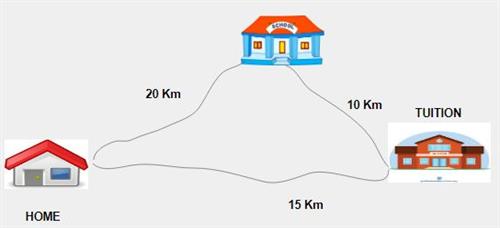PDF chapter test TRY NOW
Objective:
To learn about the distance and displacement using day to life example.
Consider Amir and Akash are brothers, and they go to school from home together every day. But one day, Akash decided to reach school after attending tuition. The path they travelled is given in the figure.

So from the above details, can you tell which person took the longer path to reach the school?
Clearly, the path Akash travelled to school is relatively longer than Amir travelled.
Therefore, Amir reached school faster than Akash, because Amir travelled in the shortest path.
That is the shortest path, the quickest way to travel from one place to another place. Mostly the shortest paths are like straight-line path.
Now let us see the definitions of distance and displacement.
Distance:
The total length of a path taken by an object to reach one place from the other is called Distance.
The SI unit of distance is metre (m).
In this case, the total distance travelled by Amir from home to school is 20 km, and the total distance travelled by Akash is 25 km.
Displacement:
It is the shortest distance from the initial to the final position of an object.
The SI unit of displacement is metre (m).
Amir travelled 20 km, which is the shortest distance from home to school.
But even though Akash took the longest distance to reach school, if he travelled faster than his brother, how can be reach school quickly than Amir? Keep thinking!!!!
In the next exercise, We will learn about speed, and there you understand the displacement with respect to speed.
Important!
Distance only gives the distance covered by an object in numerical value. But, the displacement gives distance with direction.
